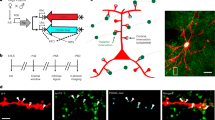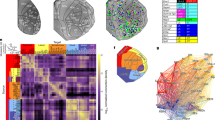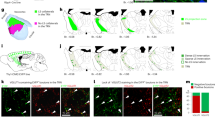Abstract
IN view of the recent deduction by experimental neurophysiologists1 of the presence of ‘interneurones’ in the region of the somato-sensory relay (ventralis posterior) nucleus of the thalamus, it would seem timely to recollect that such neurones are almost certainly demonstrable under the light microscope (and generous to recall that the presence of such Schaltzellen was deduced sixty-seven years earlier, from brilliant experimental and pathoanatomical observations, by von Monakow2). It is rather surprising that the first histological report of thalamic ‘microneurones’ (to the 1949 International Neurological Congress3) has not been confirmed by anatomists outside Germany4,5. The explanation probably rests largely in the fact that in most of the commoner mammals used in neuro-anatomical research the somata of the microneurones are too similar in size and shape to those of astrocytes to be distinguished with confidence. From extensive surveys in the macaque (in celloidin-embedded, well-differentiated cresyl-violet preparations) I have ascertained that the microneurones tend to be proportional in size to the macroneurones in most of the sub-nuclei of the thalamus, and hence largest in nucleus ventralis posterior pars gigantocellularis. Unfortunately, again, the most commonly studied sub-primates do not possess a conspicuous pars gigantocellularis. In the dog, however, it is well developed, and its microneurones are as prominent as in the macaque. In both the dog and the rabbit, but not so far in the macaque, I have obtained occasional thalamic sections, impregnated by the silver sulphide method and counterstained by methylene blue6, in which the display of heavy-metal granules is distinctly more condensed, and hence blacker, in the cytoplasm of the astroglia than in both orders of neurones.
This is a preview of subscription content, access via your institution
Access options
Subscribe to this journal
Receive 51 print issues and online access
$199.00 per year
only $3.90 per issue
Buy this article
- Purchase on Springer Link
- Instant access to full article PDF
Prices may be subject to local taxes which are calculated during checkout
Similar content being viewed by others
References
Andersen, P., and Eccles, Sir John, Nature, 196, 645 (1962).
von Monakow, C., Arch. Psychiat., 27, 1, 386 (1895).
McLardy, T., J. Neurol. Neurosurg. Psychiat., 13, 198 (1950).
Hassler, R., Cong. Latinoamer. Neurocir., Montevideo, 754 (1955).
Namba, M., J. Hirnforsch., 4, 1 (1958).
McLardy, T., Nature, 194, 300 (1962).
Lemieux, L. H., J. Neuropath. Exp. Neurol., 13, 343 (1954).
Turner, J., Brain, 26, 400 (1903).
Waddy, F. F., and McLardy, T., Confin. Neurol., 16, 65 (1956).
Author information
Authors and Affiliations
Rights and permissions
About this article
Cite this article
MCLARDY, T. Thalamic Microneurones. Nature 199, 820–821 (1963). https://doi.org/10.1038/199820a0
Issue Date:
DOI: https://doi.org/10.1038/199820a0
This article is cited by
-
Neuronal types in the neocortex-dependent lateral territory of the human thalamus
Anatomy and Embryology (1984)
-
Post-Natal Origin of Microneurones in the Rat Brain
Nature (1965)
Comments
By submitting a comment you agree to abide by our Terms and Community Guidelines. If you find something abusive or that does not comply with our terms or guidelines please flag it as inappropriate.



